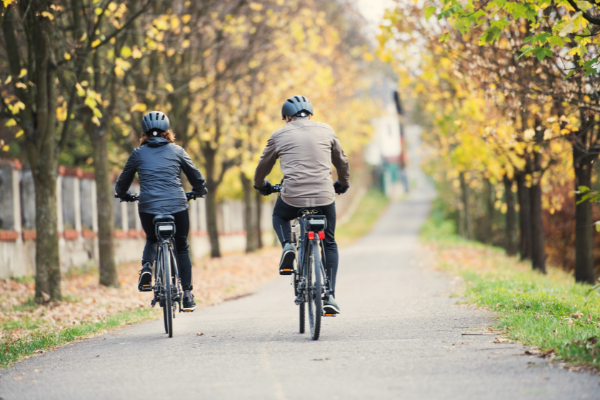Electrically assisted bicycles are all the rage among riders of all stripes. Check out what makes e-bikes so appealing to so many people, and learn what to look for if you go on the hunt for the right e-bike for you.
If it seems like bicyclists are zooming by you faster than ever these days, you might not be imagining things. Those riders could be on e-bikes—electrically assisted two-wheelers that can hit speeds of 20 miles per hour or faster.
E-bikes’ popularity has exploded in the past few years, with sales soaring by 72 percent in 2018 alone, according to NPD Group. The pandemic also helped e-bikes get noticed, as more people across the country—including non-bikers and people who generally avoid the great outdoors—sought ways to have fun in the sun and get around. One report by CIE, CONEBI and ECF predicts that the e-bike market will grow from 3.7 million bikes sold in 2019 to 17 million in 2030.
All this raises the question: Should YOU become an e-bike owner? We reached out to the pros and experts who test e-bikes at Bicycling Magazine and Consumer Reports for their insights—and their top tips for choosing the right type of e-bike based on your needs and wants.
Putting the E in e-bikes
The e-bike concept is pretty straightforward: In general, they are bikes with extra power courtesy of a small, battery-powered motor that helps propel you forward. When you pedal, the motor kicks in and gives you a boost—referred to as pedal assist—that helps you ascend hills or ride over tough landscapes faster and easier than you could with a regular bicycle. Pedal harder to get more assist—or adjust the setting to get more or less oomph depending on the terrain.
Important: Both the size of the battery and how much you engage it will impact the length of time the battery will last before you need to charge it (more on that later).
Some e-bikes also come with a throttle that engages the motor by pressing a button or twisting the handlebar.
The case for e-bikes
The idea of a motor-assisted bike appeals to a broad swath of people—including people with health issues who may need or want some help beyond the power of their own legs, urban commuters who want to get to work (and back home) faster, and even dedicated riders seeking some extra juice due to age or health issues.
For these and other types of riders, e-bikes offer some intriguing benefits:
- Health benefits with less effort. Yes, e-bikes do some of the work. But they can still help you get healthier—particularly if you’re leading a fairly sedentary lifestyle. Example: In a University of Colorado Boulder study, 20 non-exercising volunteers who were sedentary car commuters rode an e-bike for 40 minutes three times per week. They showed improved cardiovascular health—including increased aerobic capacity and improved blood sugar control—in one month.
- Motivation to bike more often. According to researchers, “the electric assist of the e-bike helps to generate more trips, longer trips and different types of bicycle trips. These findings are represented by the high value attributed to being able to overcome hills easier, ride farther and faster with less effort, and being able to carry more cargo or children when needed. When the respondents’ most recent e-bike trips were analyzed, the results indicated that e-bikes have the capacity to replace various modes of transportation commonly used for utilitarian and recreational trips, including motor vehicles, public transit and standard bicycles.”
Then there’s this: Before owning an e-bike, 55 percent of e-bike owners in one survey by the National Institute for Transportation and Communities said they rode daily or weekly. After getting an e-bike, that number soared to 91 percent riding daily or weekly.
- Better mental health. Our brain power can potentially diminish as we age. One U.K. study showed that older adults (age 50 to 83) who rode e-bikes regularly experienced stronger cognitive function, faster processing speed and better scores in terms of overall mental health than did non-bikers. The study suggested that e-bikes might even deliver stronger benefits than traditional pedal bikes.
Navigating the e-bike universe
Ready to buy an e-bike? Not so fast. You’ve got some choices to make—from what type of motor you want to the style of e-bike that will fit your needs.
Start with the component that makes an e-bike unique: the motor. There are two main types:
- Mid-drive motors. As the name suggests, these motors are located in the middle of the e-bike. Generally, mid-drive e-bikes will deliver more torque—making them better options if you’ll be biking in areas with steep hills or if you expect to go off-roading or mountain biking regularly.
- Hub-drive motors. You’ll find these motors in the center of the front wheel or the rear wheel of the e-bike. They’re generally found on bikes that appeal to riders such as commuters or families with young kids who are looking to travel for short or long distances on smooth, mostly flat surfaces.
Next, consider the type of riding you think you’ll be doing the majority of the time you’re on an e-bike, and find a type of bike that’s aligned with and supports your riding style. The really good news here, says Bicycling’s Lou Mazzante, is that you can find an option for just about any riding style. These are some of the major e-bike categories today:
Transportation/utility bikes
This is the traditional market for e-bikes, and they are used largely by families, commuters and delivery services in urban areas. These bikes are also popular among the RV crowd, who use them to travel around their campsite and to explore the local area when they travel.
These are sturdy bikes designed to haul cargo ranging from groceries to luggage to children. As such, they are heavy—don’t be surprised if a cargo-based e-bike weighs 80 pounds before you add your stuff. That weight also means that how and where you store your bike should be considered, as lugging an 80-pound bike up stairs might not be what you’re looking for.
Mountain bikes
E-mountain biking has taken off in Europe and is becoming increasingly popular in the United States. Riders who want to experience mountain biking but may not have the strength or stamina to do so are gravitating to e-bikes—as are older mountain bike and off-road riders who may be slowing down or experiencing health issues that make it tough to ride rough.
These bikes are lighter than cargo-style bikes, but even within the category there are options. Whereas many e-mountain bikes weigh around 50 pounds, a few are in the 30-pound range. Lighter bikes may lack some of the power of their larger peers but can deliver a more energetic ride.
Mazzante recommends going with a mountain bike with a motor made by a name-brand company known for quality, and making sure the bike is adept at managing torque—as you don’t want the bike to unexpectedly lurch forward on you.
Fitness bikes
Some of the newest entries into the e-bike universe are aimed at racers and high-performance riders—those geared-up people biking in large groups down the road on weekends. These riders, who tend to value the athleticism and effort involved in their rides, often are looking for e-bikes to give them a boost at select moments—such as when they encounter a particularly tough incline. Having a source of constant motorized assistance isn’t usually a top priority.
Ultimately, the big selling point for e-bikes in any of these three categories is that they can make it easier for you to do whatever it is you want to do on your bike—from getting to work fast to being able to do an all-day ride. As a buyer, your biggest job is to determine how you’re going to ride—and choose accordingly.
How far can you go?
Once you start looking at particular bikes that match up with your riding goals, you’ll want to understand how far you’ll be able to go on an e-bike before the battery dies and your pedal assist boost won’t kick in. After all, if you’re relying on an e-bike to help you get through a 50-mile ride and the battery conks out at mile 30, you won’t be a happy biker.
This is when you’ll enter the world of volts, amps and other e-bike power measurements. We recommend that you have a trusted bike shop pro take you through the math on specific bikes. Chances are, he or she will tell you the key metric to focus on is the bike’s watt hours (Wh)—a measurement of a battery’s capacity that helps tell you how far the bike should go on a single charge.
Watt hour capacity is found by multiplying the battery’s amp hours (Ah) rating and voltage rating (V)—both of which are listed on the battery itself. For example, a 48 V battery rated 10 Ah has a capacity of 480 Wh.
What does that mean for longevity? Lots of variables impact an e-bike’s range—your weight and riding style, the terrain (flat vs. hilly) and weather conditions, the extent to which you engage the pedal assist feature (or the throttle if the bike has one), the amount of cargo you’re carrying, and even your tires. That said, on average, an e-bike battery can reasonably be expected to yield one mile of travel for every 20 Wh of energy. So in the example noted above, you might expect the battery to last for 24 miles—again, keeping in mind that all those variables noted above can change the end result. If you’re a bike enthusiast who loves to pedal on your own as much as possible and engage pedal assist only on tough climbs, you can expect to get one mile of travel for less than 20 Wh of energy.
The upshot: The math can get fuzzy here. But a good rule of thumb with e-bikes, as with lots of technology, is to be wary of a manufacturer’s wild claims. Sure, an e-bike might take you 100 miles on one charge—but only if you barely use the assist and pedal hard the whole way in ideal weather conditions. If it sounds too good to be true, it likely is.
Conclusion
Chances are, if you don’t already know someone with an e-bike, you will soon.
Hopefully the information detailed above is helpful—but frankly, your best bet is to hop on an e-bike yourself and give it a test ride to decide whether this souped-up twowheeler deserves a spot in your garage.
ACKNOWLEDGMENT: This article was published by the VFO Inner Circle, a global financial concierge group working with affluent individuals and families and is distributed with its permission. Copyright 2021 by AES Nation, LLC.
This report is intended to be used for educational purposes only and does not constitute a solicitation to purchase any security or advisory services. Past performance is no guarantee of future results. An investment in any security involves significant risks and any investment may lose value. Refer to all risk disclosures related to each security product carefully before investing. Securities offered through Fischer Financial Services. Vernon Fischer is a registered representative of Fischer Financial Services. Vernon Fischer and Fischer Financial Services are not affiliated with AES Nation, LLC. AES Nation, LLC is the creator and publisher of the VFO Inner Circle Flash Report.
Get in Touch
Want to discuss your family business? Set up an appointment at your convenience:
Please stay safe and stay healthy.
Vern Fischer






